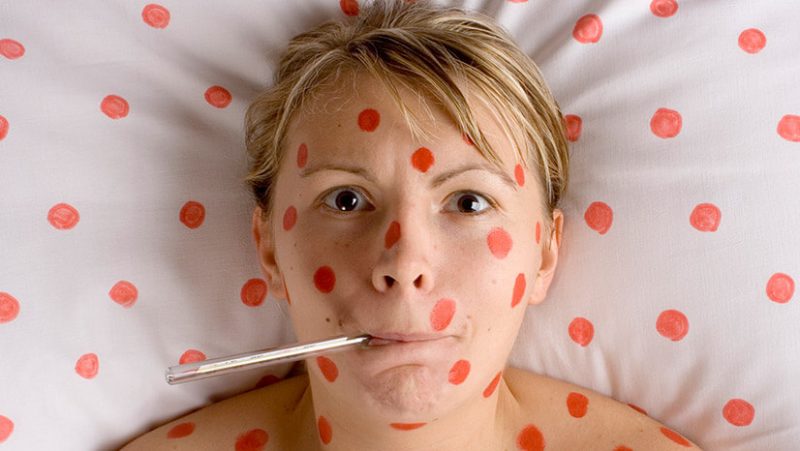Chicken pox is a viral disease that is more common in preschool and school children. The disease is contagious, and if the team has a sick person, the chance of catching the virus is 99%. That is why many are interested in how chickenpox begins.
Material Content:
The incubation period in children and adults
The incubation period lasts from 7 to 21 days. It all depends on the human immunity - the stronger it is, the longer the disease will not make itself felt.
In children aged 3 to 12 years, the period of time from the moment of infection to the onset of the first symptoms of the disease lasts 14 days, in babies up to 3 years - 7-8 days, in adults - 16-21 days.
It should be noted that the entire incubation period can be divided into several stages:
- Elementary. The virus enters the human body and is firmly fixed on the mucosa (in the nasal or oral cavity). At this time, the patient does not feel any signs of the disease.
- The period of development and reproduction of the virus. At this time, viruses descend into the human respiratory tract. At this stage, the patient may feel the first signs of the disease: dry cough, runny nose, tearing of the eyes.
- The final one. The virus enters the bloodstream in large quantities, spreads throughout the body. Healthy cells begin to actively respond to it. The first acne appears on the body, which eventually fills with liquid and turns into papules.
A person becomes contagious 1-2 days before the appearance of the first rashes on the body. If chickenpox is found in a preschool or school team, quarantine is declared in the institution.
Children are examined daily by a nurse or staff doctor, body temperature is measured, wet cleaning is carried out using disinfectants. Quarantine lasts 14 days.
The first signs and symptoms of chickenpox
Many confuse the first signs of chickenpox with commonplace SARS or the flu. You will be surprised, but we are not talking about rashes at the initial stage of the disease.
 So, the first symptoms of the disease are as follows:
So, the first symptoms of the disease are as follows:
- Slight sore throat, dry cough. The virus enters the upper respiratory tract, so such signs are not uncommon.
- Watery eyes. Many may confuse a similar symptom with the onset of conjunctivitis. At the same time, the eyes do not itch, but photophobia appears.
- Slight runny nose. The snot is not thick, a clear liquid is released from the nasal passages.
- General weakness, lack of appetite. The virus poisons the body, this leads to intoxication, worsening of the patient's condition. Many patients want to lie down, they tend to sleep.
The first symptoms of chickenpox in adults are completely identical to those in children. They can be present in a person from 1 to 3 days, then rashes on the body will follow.
How not to confuse chickenpox with a cold? You should be alerted by the fact that with the above symptoms, the patient remains normal body temperature indicators.
Where rashes appear
The first rash is formed in the head area (on the hair), so many do not notice it. As well as pimples can be observed in the abdomen (near the navel) and on the back.
 Further, the rash spreads throughout the body. It is worth noting that acne can also be on the mucous membranes (in the mouth, on the genitals, eyes). This symptom indicates a severe course of chickenpox. You will need special drugs that can treat the affected areas.
Further, the rash spreads throughout the body. It is worth noting that acne can also be on the mucous membranes (in the mouth, on the genitals, eyes). This symptom indicates a severe course of chickenpox. You will need special drugs that can treat the affected areas.
As doctors note, acne on the feet and palms of chickenpox is almost always absent.
What does a rash look like
At first, rashes may resemble a mosquito bite. A small tubercle of bright red color forms on the skin. The patient is able to feel itching and discomfort. In a few days, almost the entire body of the patient is covered with such a rash.
Literally in a day, a pimple turns into a papule, around which a red rim forms. Gradually, the nodules significantly increase in size.
 Further, the upper layer of the epidermis disappears and the patient can observe bubbles filled with liquid on the skin. It should be transparent, odorless. When pus or fluid with blood begins to stand out from the papule, this is the first sign of complications, the attachment of a bacterial infection. In this case, you should immediately consult a doctor.
Further, the upper layer of the epidermis disappears and the patient can observe bubbles filled with liquid on the skin. It should be transparent, odorless. When pus or fluid with blood begins to stand out from the papule, this is the first sign of complications, the attachment of a bacterial infection. In this case, you should immediately consult a doctor.
If you properly handle papules resembling small wounds, then in 1-2 days they will be covered with crusts. They can not be removed on their own, as scars will remain on the skin that can be removed only with the help of cosmetic procedures (resurfacing, laser).
Within a week, the peels will fall off on their own, the skin will become clean.
Can it start with legs
A rash with chickenpox can begin with the legs. But doctors say that such a place to localize pimples is extremely rare.
In any case, you need to observe the patient. If it is chickenpox, then within a few hours the rash will spread throughout the body.
How long does chickenpox last in children and adults
Chickenpox in children is much easier than in adults. That is why many doctors recommend having an illness at an early age.
As a rule, the disease affects children for a period of 7 to 10 days. Of these, 3-4 days the baby is very "strews". The task of parents is to relieve itching, not allowing them to comb papules.
In adults, the disease is difficult, on average, lasts from 10 to 14 days. Hospitalization of the patient is often required.
If an adult with chickenpox rises in temperature above 39 degrees, there is pale skin, heavy rashes (including on the mucous membranes), loss of consciousness, it is necessary to call an ambulance team for hospitalization in a hospital.
Remember, chickenpox is a serious illness that can cause serious complications. According to statistics, out of 10 thousand cases, 2 are fatal.
Chicken pox treatment
How to treat chickenpox? Doctors recommend the following regimen:
- Antipyretic drugs.As a rule, during the rash, the temperature rises to 38-40 degrees. Children can be offered drugs: Paracetamol or Nurofen. In severe cases, candles "Analdim" will help. They include analgin and diphenhydramine. Kids under 5 years old are allowed to use 1 candle per day. Adults can be offered: "Paracetamol", "Nimesil", "Ibuprofen". Use "Aspirin" is prohibited. This can lead to kidney failure.
- Antihistamines. “Fenistil” is suitable for babies up to one year old. Older children can take "Zodak", "Diazolin", "Suprastin." Doctors prescribe Centrin, Agistam for adults.
- Antiviral. These drugs are used only for severe chickenpox. If before doctors recommended “Acyclovir”, now there is an analogue to this drug, for example, “Groprinazin”. This tool does not adversely affect the liver and enhances immunity.
Chickenpox is caused by the herpes virus. The disease is not treated with antibiotics.
Huge discomfort with chickenpox causes itching.
Therefore, in order to get rid of it, it is very important to correctly process the papules:
- "Tincture of calendula". The drug is alcohol-based, it well dries pimples, disinfects them.
- "Psilo balm." The gel has a transparent dense structure. Can be applied to mucous membranes. Balm quickly removes itching, relieves swelling and inflammation.
- Tsindol. White liquid, which quickly relieves itching, dries papules well.
- Calamine. Relieves itching, inflammation, promotes early healing of wounds. The disadvantage of the drug is its high price (1000-1200 rubles).
- Miramistin. An excellent tool with which you can process the mucous membranes.
Modern medicine is ambiguous about drugs such as Diamond Green and Fucorcin. These funds only dry the papules, causing a person to even more itch. In addition, drugs are difficult to remove from skin and clothing, so it is better not to use them.
The chickenpox virus is the causative agent of chickenpox. Can I protect myself from the disease? The only preventative measure is vaccination. But even vaccination does not give a 100% guarantee. However, in this case, the disease is tolerated much easier.
It was previously believed that, having once had chickenpox, a person receives lifelong immunity. Modern medicine has proved the fallacy of this opinion.
It is important to know the first signs of chickenpox in order to start treatment as soon as possible, and to eliminate the possibility of complications. We hope that the information presented in the article will help you recognize the signs of the disease at its initial stage.













